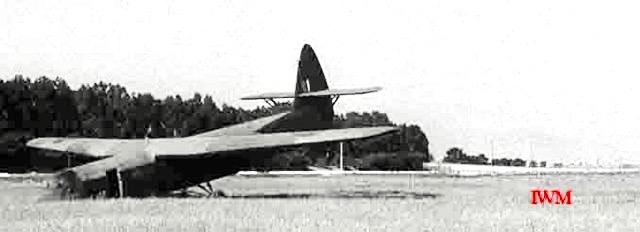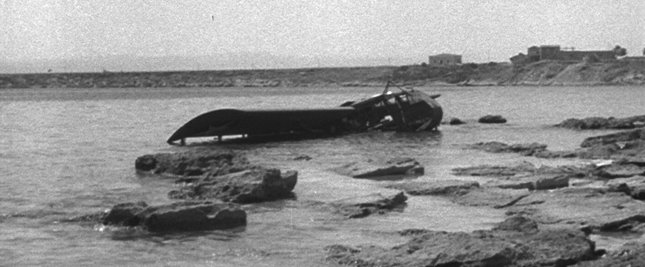From Drop Zone Sicily and Canadians in Combined Operations
"An Albemarle towing a Horsa glider" Photo - wikipedia
The following passages or excerpts relate to airborne glider mishaps that occurred during the invasion of Sicily in 1943.
Canvas bags, tags and wooden crosses
Gusty swirls of wind and dust
whipped across the Tunisian airfields,
buffeting the hordes of flimsy gliders
and their tow planes. From the six fields
144 airplanes would tow 136 American-
made Waco and 8 British Horsa gliders
to their release points.
Elsewhere on the same field,
a glider pilot was overseeing last-minute
loading of his aircraft. He saw a large trailer,
covered by canvas, being maneuvered into
his glider. Curious as to its contents,
he raised the canvas cover slightly,
and what he viewed caused his blood to chill.
The trailer was loaded with canvas bags, tags
and wooden crosses - enough to bury and mark
the graves of scores of Red Devils in Sicily.
Hurriedly releasing the cover, the pilot made
no mention to others of his gruesome discovery.
Suddenly the tranquillity
at the six Tunisian airfields was shattered.
With an ear-piercing roar that echoed
and re-echoed across the dusty surface,
the powerful tow planes - C-47s, Albemares
and Halifaxes - revved motors, and at 6:42 P.M.
a ground crew hitched the first tug to its glider.
One by one, the tug-glider combinations roared
down the runways. The gale-force winds had
whipped up thick clouds of dust, and pilot
visibility was zero as the aircraft
lifted into the sky.
(From Drop Zone Sicily by W.B. Breuer, pages 40 - 42)
Inexperienced Pilots became Confused
The sky armada was passing directly
over a huge convoy which was carrying General
Montgomery's British Eighth Army to the beaches.
Minutes later, as the tow planes and gliders began
the 18-mile stretch run up the east coast of Sicily
to the glider-release point near Syracuse,
land-based searchlights suddenly flashed on,
sending brilliant fingers of white into the dark sky.
Enemy antiaircraft batteries in darkness far below
went into action, and flak began exploding around
the gliders and tow planes, leaving the sky dotted
with wispy puffs of black smoke.
Photo Credit - Imperial War Museum
The flight formation, already disrupted
by the heavy gale, disintegrated. The shoreline
and the glider-release point were shrouded by huge,
billowing clouds of thick dust and sand whipped up
by the high-velocity winds. Smoke from fires set by
Allied bombers helped to obscure landmarks. Unnerved
by their first taste of enemy gunfire, blinded by searchlights,
unable to see checkpoints due to the heavy ground smog,
the inexperienced pilots became confused.
Some aircraft turned inland to skirt
the pervasive accumulations of blowing dust, sand and
smoke, dodging and weaving to avoid midair collisions.
Some pilots dipped closer to the ground to escape the
fixed glare of the searchlights and to get their bearings.
Others gained altitude. Pilots turned to the left.
Others banked to the right.
In the chaos, a number of tow planes
climbed to 3,000 feet, and their gliders released
high above the other tug-glider combinations.
The released gliders then drifted down through the
wildly gyrating aircraft flying at a lower level.
Most gliders were cut loose at random, and soon
the moonlit sky was awash with motorless craft moving
inexorably toward crash landings somewhere in Sicily.
Photo Credit - Operation Ladbroke
Crashed gliders, lying silently in grotesque,
twisted masses or burned to a crisp, were scattered about
the landscape over a wide expanse of southeast Sicily.
The mutilated bodies of Red Devils and pilots were
entwined in the wreckage or lay mutely on the ground nearby.
One glider flew into the face of a cliff. The mangled bodies
of the pilot and copilot were still strapped to their seats...
(From Drop Zone Sicily by W.B. Breuer, pages 45 - 48)
"The crew in one of our LCMs approaching the site of a glider crashed against the
cliff near the Noto landing beach." Photo - D. J. Lewis (RCNVR, Comb. Ops) in
A Tragic Mass of Metal
and (breathing in) the dreadful smell that went
with it, fifty-two and one-half years have passed.
The experience remains uncomfortably vivid.
However, I have continued to wonder why this
particular glider pilot had come in a few feet below
the top of the cliff side. Answers have been various.
Either he had been gliding too low, too slow, too
heavy laden or had he hit a last minute down draft?
However, he struck the cliff and collapsed everybody
and everything against it into a heap at the water line;
a tragic mass of metal, wood and aviation fabric
interspersed with human remains.
particular glider pilot had come in a few feet below
the top of the cliff side. Answers have been various.
Either he had been gliding too low, too slow, too
heavy laden or had he hit a last minute down draft?
However, he struck the cliff and collapsed everybody
and everything against it into a heap at the water line;
a tragic mass of metal, wood and aviation fabric
interspersed with human remains.
Further out to sea we could see (drowned) soldier
comrades hovering like mermen in the greeny blue depths
of the clear Mediterranean waters. Down there they seemed
to keep station until internal gas brought them to the surface
at irregular intervals during the first fortnight after the Sicilian
landings. Then they were towed over to the landing beach
where their dog tags were noted and they went
to a permanent or temporary grave.
(From Short Story re Sicily, "Airborne Mishaps")
We Saw Gliders Everywhere
A signal came through,
i.e., ‘do not fire on low flying aircraft,
they are ours and towing gliders.’
What, in the dark?
Next morning,
as we slowly moved in
(on Landing Craft, Mechanized),
we saw gliders everywhere.
I saw them sticking out of the water,
crashed on land and in the vineyards.
In my twenty-seven days there
I did not see a glider intact.
(Observations of Canadian L/S D. Harrison, Memoirs, Ch. 7 - Sicily)
(Observations of Canadian L/S D. Harrison, Memoirs, Ch. 7 - Sicily)
"Drowned Operation Ladbroke glider... pillbox can be seen in the background."
Photo Credit - Terror off Terrauzza
Please link to Passages: "The Great Invasion Fleet" by Farley Mowat





No comments:
Post a Comment